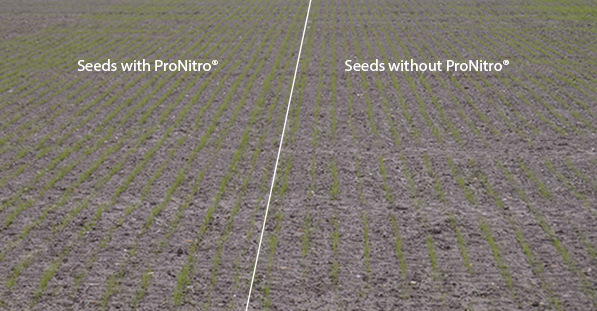Give grass seed a head start
Give your seeds a nutritional head start with a coating of ProNitro®, the mixture of slow and fast-release nitrogen. No need for fertiliser the first month because each seed comes with its own packed lunch of nitrogen.
ProNitro® is proven to improve grass growth
ProNitro® has proven itself through numerous tests and trials. Emergence and grass density are improved; forage yields can be anything from 5% to 20% higher in the first year.
- Better early growth from stronger plants with 30% longer roots, improved stress-tolerance, and an average of 30% more viable plants.
- More efficient use of nutrients with fertiliser applied directly to the root zone.
- Bigger and heavier seed provides better contact with soil surface.
- Feeds the seed only, not weeds or surrounding grass.
- Colourants reduce losses through bird picking
ProNitro® is very suitable for overseeding with its fast establishment and fertiliser coating.
Take a look at our video on how to use our ForageMax® overseeding system with ProNitro®.

Seeds coated with ProNitro® to the left and seeds without ProNitro® coating to the right.
ProNitro® boosts grass growth and milk yields
ProNitro® is a grass-seed coating offering a unique combination of fast and slow-release nitrogen. Because the nitrogen is wrapped around each seed in an easily accessible format, the germinating seed can tap into it straight away. Blades of grass emerge sooner and more densely. You give your sward a head start that leads to increased forage and milk yields.
ProNitro® combines seeding and fertilising in a single pass. All the nitrogen your grass seed needs for fast establishment comes ready-wrapped around the seed.
- Coating increases seed weight by 50%
- Nitrogen accounts for 10% of seed weight
Treated seed has a better start in life
At DLF we're constantly pushing performance boundaries with new varieties of grass seed offering improved characteristics. Even so, customers often prefer to spend a bit more so that they can sow treated versions of those seeds. They're making a sound investment because sowing conditions vary from farm to farm and from year to year. Treated seed has a much better chance of thriving under adverse conditions when untreated seed might fail.
The use of treated seed is common farming practice for the sowing of cereals, beet, and maize. Now farmers are applying the same approach to grass, especially in locations where there are restrictions on the use of chemicals and fertilisers.
ProNitro® trials
UK, Lincolnshire, Scarborough
Soil type: organic matter content >7%.
Seed mixture: 50/50 diploid and tetraploid perennial ryegrass
Sowing date: 9 September 2014
We examined the trial field three times until 28 October. On all three occasions the ProNitro® strips were a darker green than the control strips. Four weeks after sowing, the ProNitro® density was 4,6 compared to a control density of just 4,2.
The Netherlands: Landhorst
Seed mixture: 50/50 diploid and tetraploid perennial ryegrass
Sowing date: 18 October 2014
Two weeks after sowing, ProNitro® seedlings were taller and darker than the control. The effect was visible all the way through till the final field assessment undertaken five weeks after sowing.
The following spring the height of the ProNitro® plants was more uniform than the control. The denser sward also suppressed Poa annua infestation, measured in May 2015 at just 5% in the ProNitro® strips compared to 10% in the control.
